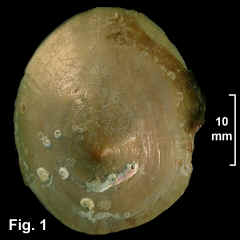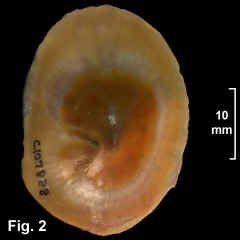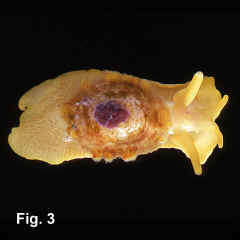|
|
TYLODINIDAE |
|
|
|
Tylodina corticalis (Tate, 1889) Description: Shell lightweight, limpet-shaped, nearly flat or moderately elevated, apex approximately central. Shell fawn, smooth and glossy apart from irregular concentric growth lines. Interior with horseshoe-shaped muscle scan. Exterior with thick periostracum with 11-20 strong radial ribs Size: Shell up to 40 mm in maximum dimension. Distribution: Endemic to Australia; southern Qld southwards and around southern Australia to south-western WA. Habitat: Lives from the intertidal down to at least 165 m, occurring in small numbers in intertidal pools in April to May each year (Burn, 1989). Uncommon in NSW. Comparison: The shell is similar to that of Umbraculum umbraculum, but the animal is very different; yellow in colour, without pustules, and with a large head and prominent tentacles and rhinophores. Remarks: This species has an animal about twice the length of the shell, light to bright yellow in colour (Fig. 3) The body is smooth, in contrast to the coarsely pustulose animal of Umbraculum umbraculum. It lives among and feeds on aplysinellid sponges. A full description of the anatomy and occurrence was given by Burn (1960). A photo of the live animal is on the Sea Slug Forum at http://www.seaslugforum.net/find/tylocort Figs. 1, 2: Exterior and interior of shell. (Kurnell, Botany Bay, NSW C.107888). Fig. 3: Live animal (Photo Bill Rudman, Australian Museum). Fig. 4: Dorsal view of animal (Fig. 2(a) from Thompson (1970)). |
|



